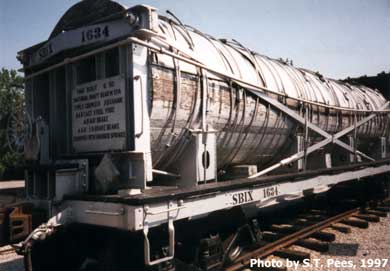 |
||||||
Special Cars
In the 1920’s there were three main types of tank cars (Day, 1922) besides the regular or standard tank car which was used principally for certain crude oils and refined products which didn’t require heating. They were:
1. Heated cars were used to carry highly viscous crudes and certain refined products like some fuel oils, waxes and asphalts. This was brought about by hot pipes (heater pipes) that did not allow the liquid to congeal or otherwise be affected by low temperatures.
2. Compartment cars had two or more separate sections so that different grades of product could be carried without mixing.
3. Insulated cars were coated with cork, hair felt or other materials and extra metal sheeting was also put in place to reduce evaporation of the load of gasoline.
The wax in the crude oil (especially some eastern oils and those of Utah) is a very commercial byproduct of some crudes. Wax undergoes various refining stages (there are several kinds of waxes) and requires heating in order to unload the tank cars. The cars may take several days of standing and heating to drain the basic wax out of them at the plant where further refining is to be carried out.
In the 1950’s and up to present, steam coils are used in tank cars loaded with heavy oils. Heating the heavy oil in this fashion lowers the viscosity and makes discharge easier. In the case of bitumen, steam coils and steam-jacketed valves are used plus the cars are insulated in order to reduce heat loss. Flame tubes and oil burners are used in some cases (Shell, 1959).
Special tank cars are built for loads having very high pressures such as in the transporting of liquefied petroleum gas (LPG).
 |
Special tank cars were built to carry a lot of liquids besides petroleum. However, most of us wouldn’t think of vinegar. Standard Brands Industries among their many other products, was in the vinegar bottling and sales business. One of their subsidiaries (Fleishmen Transportation Company) built this vinegar tank car in 1950 out of cypress and fir wood. Metal could not be used because vinegar is very corrosive. The tank cars were painted silver to reflect sunlight and to help to keep the vinegar cool. The tanks had a relatively short track life. This car caught the author’s attention because it appeared so retro and shabby compared to the other rolling stock in the impressive railroad car and engine display in St. Louis, Missouri.
|
![]()
| © 2004, Samuel T. Pees all rights reserved |
|